|
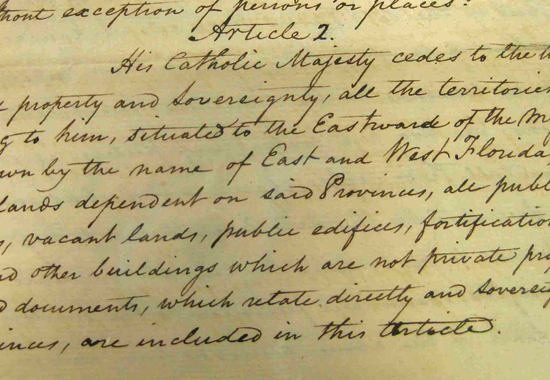
"His Catholic Majesty cedes... East and West Florida"
Adams-Onis Treaty 1819
The Adams-Onís Treaty is also called the
Transcontinental Treaty,
or the Purchase of Florida.
The actual title on the document
reads
"Treaty of Amity,
Settlement, and Limits, between the United States of
America, and His Catholic Majesty."
Who Signed?
 John Quincy Adams for
the United States
John Quincy Adams for
the United States
under  President James Monroe
President James Monroe
and
Luis de Onís
for Spain
under King Ferdinand VII
And these two negotiated their salaries' worth. Here is a
 peek into their negotiations
.
peek into their negotiations
.
What Was Agreed
Upon?
The U.S. agreed to pay up
to five
million dollars to U.S. citizens who demanded compensation
for loss or damage of property from Spain.
Spain ceded East and West
Florida and renounced claims on Oregon Country. The U.S.
renounced all claims on Texas and
then some.
This is the map:
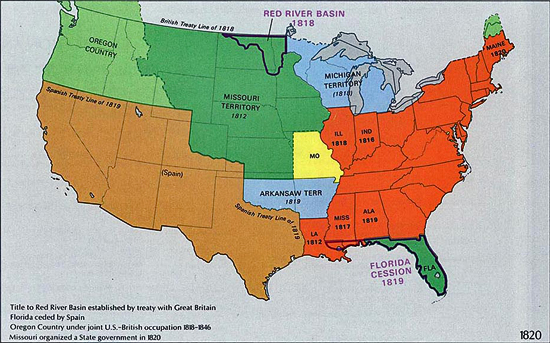
U.S. Expansion: The Map in 1820
Illustrating: Title to Red
River Basin established by treaty with Great Britain.
Florida ceded by Spain (Florida Cession 1819).
Oregon Country under join U.S.-British occupation 1818-1846.
Spanish Treaty Line of 1819.
Missouri organized a State government in 1820.
Click to enlarge (huge map)
Thanks to Spain's waiver of its
claims on Oregon Country, the United States stretched now uncontested across the continent from coast to coast. Hence,
this is also called the Transcontinental Treaty.
Direct access to the Pacific was
valuable in many ways, one example being new opportunities
of commerce with Asia.
And here are
 more maps that
illustrate the Adams-Onis Treaty of 1819.
more maps that
illustrate the Adams-Onis Treaty of 1819.
When Was the
Treaty
Signed?
Adams and Onis signed at
Washington D.C. on February 22, 1819.
When Was It
Ratified?
::
United States
Unanimous Senate approval (34 Yea and 8 not voting) on February 24, 1819.
The President signed the same day.
::
Spain
Spain's King Ferdinand VII
and his Secretary Fernando Evaristo
Perez de Castro signed and countersigned at
Madrid on October 24, 1820.
But according to the treaty, the
deadline for final ratification was August 22, 1819. What on
earth took Spain so long?
Spain dragged its feet for mainly two reasons:
1. land grants
and
2. Rio de la Plata
To 1: Land Grants
After agreeing during
pre-negotiations to the sale of the Floridas, Spanish
King Ferdinand VII awarded Floridian land as
a gift to some of his loyal servants. These
land grants were massive.
("Principal
Grantees" were: the Duke
of Alagon, Captain of the Body Guards; the Count of Punon Rostro,
one of his Chamberlains; and Don Pedro de
Vargas, Treasurer of the Royal Household)
On a scale from sneaky to
offensive, U.S. diplomats pinned Ferdinand's behavior more
to the right. This was
unacceptable because, so they argued, it wasn't his to give
at this point.
Moreover, one of the treaty's stipulations was that the
United States would take care of $5 million of claims
against Spain. This budget hole was to be balanced with the
proceeds of sales of territory in the newly
acquired Floridas. In other words, Spain had just helped
itself to a big chunk of the U.S. budget.
So, Spain wanted U.S.
recognition of these land grants included in the
treaty.
To 2: Rio de la Plata
But according to a private
 letter from John Forsyth (U.S.
Minister to Spain) to Adams** from August 22, 1819,
"the affair of the grants"
wasn't the only reason why Spain hesitated to ratify.
letter from John Forsyth (U.S.
Minister to Spain) to Adams** from August 22, 1819,
"the affair of the grants"
wasn't the only reason why Spain hesitated to ratify.
** go to page 7
According to the letter, Spain
also wanted "to procure an assurance that
we will not recognize Buenos Ayres."
The Viceroyalty of the Río de la
Plata or Buenos Ayres was a Spanish colony on the brink of
independence.
Here is the map:
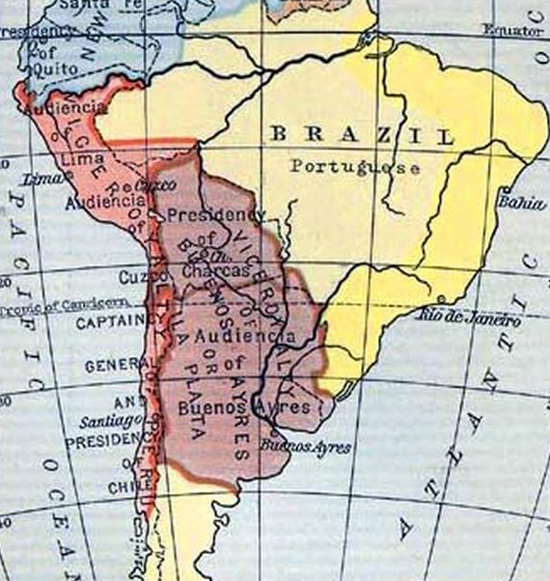
Viceroyalty of Buenos Ayres or La Plata
Map of South America About 1790
Click to enlarge
The
 Napoleonic Wars
(1803-1815) had exhausted Spain to such a degree that it
rendered the Spanish virtually powerless in their colonies.
Napoleonic Wars
(1803-1815) had exhausted Spain to such a degree that it
rendered the Spanish virtually powerless in their colonies.
These former dependencies now sought to reorganize
themselves independently, which included putting themselves
on the political map by reaching out to the
rest of the world via diplomatic ties.
So, the second reason Spain
hesitated to ratify, was that it would have liked very much if
the U.S. would obligate itself not to acknowledge any of these
independence seeking colonies.
... which seems like an odd
thing to ask from the United States, considering that they
themselves had just recently unshackled itself from their
colonial overlords, and furthermore, considering that by
this very treaty Spain clearly demonstrated that it was too
weak to prevent the breaking away of parts
of its former colonies, i.e. the Floridas.
Spain eventually realized that none of these desired
amendments had a chance to become part of the treaty.
Finally, as mentioned above, Spain ratified on
October 24, 1820, which according to the Treaty
was too late.
ARTICLE XVI
The present treaty shall be ratified in due form, by the
contracting parties, and the ratifications shall be
exchanged in six months from this time, or sooner if
possible.
Thus, Ferdinand
included in his ratification:
" ... and that the
circumstance of having exceeded the term of
six months, fixed for the exchange of the
ratifications in the 16th article may afford
no obstacle in any manner; it is my
deliberate will that the present
ratification be as valid and firm and
produce the same effects as if it had been
done within the determined period."
::
United States
Legally, the United States had to re-ratify this treaty. The United States Senate
 voted again on February 19, 1821,
and this time around it wasn't unanimous, but it still passed with 40 to 4,
and 2 abstaining. Nay voted:
voted again on February 19, 1821,
and this time around it wasn't unanimous, but it still passed with 40 to 4,
and 2 abstaining. Nay voted:
Richard Johnson, KY
James Brown, LA
William Trimble, OH
John Williams, TN
U.S. president
James Monroe signed
on February 22, 1821.
::
Exchange of Ratifications
On the same day, February 22, 1821, ratifications were
exchanged at Washington between John Quincy Adams and General
Don Francisco Dionisio Vives, Spain's Envoy
Extraordinary and Minister Plenipotentiary.
Did the United
States Pay Spain Five Million Dollars for Florida?
No.
ARTICLE XI
The United
States, exonerating Spain from all demands
in future, on account of the claims of their
citizens to which the renunciations herein
contained extend, and considering them
entirely cancelled, undertake to make
satisfaction for the same, to an amount not
exceeding five millions of dollars.
American citizens demanded
compensation from Spain. The U.S. took over this
responsibility and cleared Spain from all involvement in
these matters.
Now these U.S. citizens had to
bring their damage claims before their own government, which
promised payment of up to $5 million in total.
How was this article
implemented?
On December 21, 1821, President
James Monroe nominated to the Senate, which consented the
same day, The Commission Under the 11th
Article of the Treaty of Amity, Settlement, and Limits,
Between the United States and his Catholic Majesty, aka
the Commissioners on the Florida Treaty.
These three
commissioners were:
Hugh Lawson White, of Tennessee
William King, of Maine
Littleton Waller Tazewell, of
Virginia
Secretary to the Commission was:
Tobias Watkins, of Maryland
And Clerk to the Commission was:
Joseph
Forrest, of the District of Columbia
This Commission sieved through
all the claims that were brought before them and
verified their validity. But the sum total, without having
figured interest into it, exceeded the $5 million mark.
It was therefore decided that
nobody received interest, and all claims were only 91 2/3 %
reimbursed. Thus, the exact amount of $5 million was spent.
The Commission was pleased with
their work and disbanded on June 8, 1824.
Is the Adams-Onis Treaty Still in Force?
No. The Adams-Onis Treaty ceased to be operative on
April 14, 1903, when the
 Treaty of
Friendship and General Relations
Treaty of
Friendship and General Relations
between
the United States
of America and Spain
came into force. How so?
Here is its Article 29:
All treaties,
agreements, conventions and contracts
between the United States and Spain prior to
the Treaty of Paris* shall be expressly
abrogated and annulled, with the exception
of the Treaty signed the seventeenth of
February 1834 between the two countries for
the settlement of claims between the United
States of America and the Government of His
Catholic Majesty, which is continued in
force by the present Convention.
* This Treaty of Paris was the
 Treaty of Paris of 1898
which ended the
Treaty of Paris of 1898
which ended the
 Spanish-American War.
Spanish-American War.
And here
you can
 check all treaties currently in force.
check all treaties currently in force.
More Maps That Illustrate the Adams-Onis Treaty of 1819
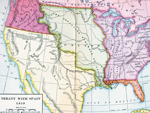
United States: Treaty With Spain 1819
Treaty Line of 1819
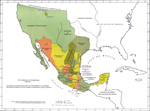
1786 - 1821 Mexico
The Viceroyalty of New Spain,
1786-1821

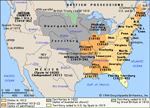
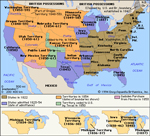
United States 1783-1854 Expansion
Three historical
maps of the Expansion of the United States
1783-1854
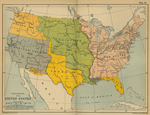
United States 1783-1907 Expansion
Map of
the Expansion of the United States 1783-1907
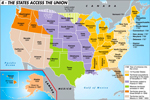
United
States 1788-1959 - The States Access the Union
Year of entrance
into the Union, territorial acquisitions
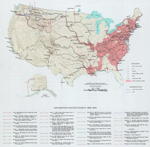
United
States 1800-1820 Exploration and Settlement
Not the treaty, but: Urban center, 1820
Extent of settled area, 1820
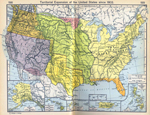
United
States 1803 Expansion
Spanish treaty
line of 1819
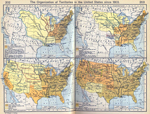
United
States 1803 Organization of Territories
Extension of the
Treaty Line of 1819 beyond the Rocky Mountains
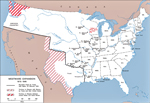
United States 1815-1845:
Westward Expansion
American Forts,
1819 Treaty Line
And here are the United States' territorial
acquisitions simplified and in a nutshell:
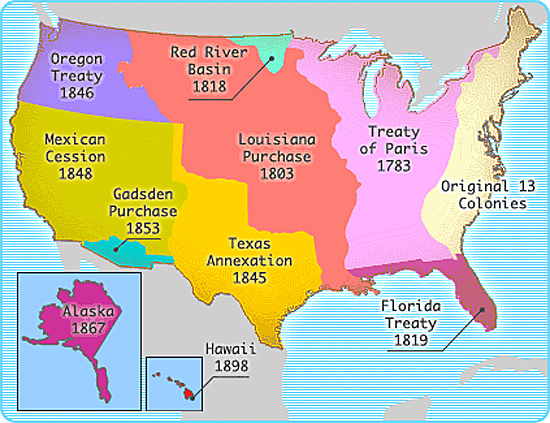
Map of the United States: Territorial Acquisitions
Humboldt State University
More History
|